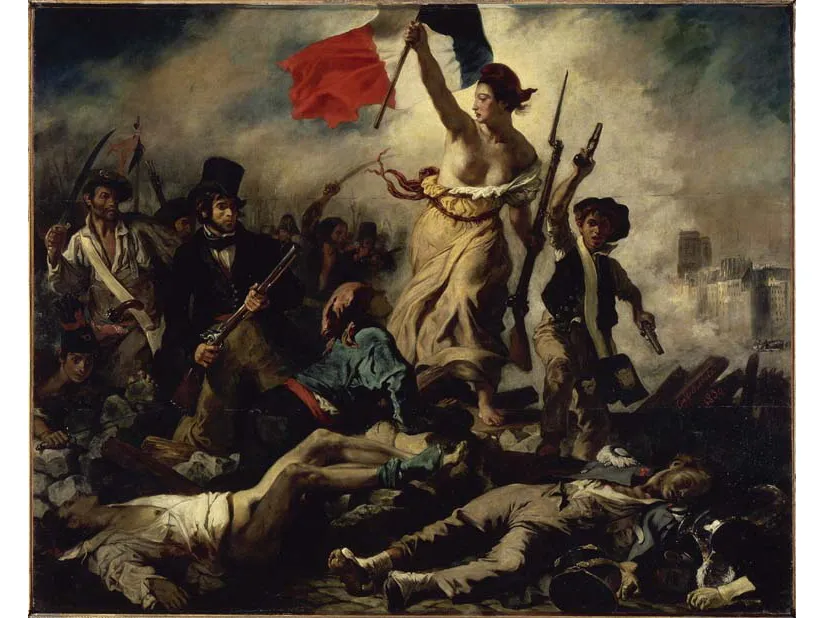There’s perhaps no more stirring an example of political art than Liberty Leading the People by Eugène Delacroix (1798–1863). Measuring roughly 8½ by 10½ feet, the painting was completed in 1830 to celebrate France’s July Revolution of the same year, which overthrew the Bourbon monarch, Charles X. More than a rousing commemoration of a contemporaneous event, Liberty became a universal symbol of the fight for freedom, equality, and justice.
Delacroix rendered his subject in the most dramatic way possible, capturing a moment when waves of rebels crest a barricade amid the smoke and fury of battle. They’re stretched in a horizontal line across the composition, surging toward the picture plane as if they were about to burst upon the viewer.
The center is dominated by one of the most iconic women in art history, the “Goddess of Liberty,” a bare-breasted figure wearing the Phrygian cap, a symbol of the French Revolution. She leads the charge over corpse-strewn terrain, urging her followers on by waving the Tricolore. On her right is a man clutching a musket and attired in the standard bourgeois uniform of frock coat and top hat, while on her left, a boy in a vest and workingman’s cap brandishes a pistol in each hand. An orgasmic culmination of righteous violence, Delacroix’s mix of allegory and realism achieves a kind of cinematic moment avant la lettre, embodying the societal and aesthetic turmoil of its time.
The July Revolution upended the political order put in place after Napoleon’s defeat, whereby Louis XVIII, brother of Louis XVI, ascended the throne, becoming the first Bourbon monarch since 1789. Louis agreed to implement a constitution called the Charter of 1814, but upon his death in 1824 he was succeeded by a hardline reactionary—his brother Charles X.
Almost immediately after taking power, Charles violated the official separation of religion and state by imposing a law that effectively ordered the death penalty for profaning the Catholic Church. He also decreed the award of reparations for properties confiscated from anyone deemed an enemy of the state (i.e., a Bourbon supporter) during the French Revolution and Napoleon’s reign—a move seen as an attempt to subvert the Charter of 1814.
Growing criticism eventually led to Charles’s attempts to permanently alter the charter, impose press censorship, and dissolve the main body of the French Parliament, the Chamber of Deputies. His actions sparked the 1830 uprising, resulting in his abdication and the establishment of a new constitutional monarchy under King Louis Philippe I of Orleans.
Liberty Leading the People was also the product of another revolution: the Romantic movement. Sweeping across Europe in the early decades of the 19th century, Romanticism rejected the rationalism of the Enlightenment to embrace the primacy of passion in creating art, music, and poetry. More relevant to Liberty’s theme was the Romantic belief that governance must be approved by the governed, an idea made concrete in Delacroix’s masterpiece.
Within French painting proper, Romanticism challenged the revival of Greco-Roman art known as neoclassicism, the house style of the Revolutionary and Napoleonic regimes. Well after the end of both, neoclassicism had retained its grip on the gatekeeping authority of French painting and sculpture, the Académie des Beaux-Arts in Paris. Through its annual Salon, the Académie controlled artistic careers while enforcing a taxonomy of genres in order of importance, with so-called history painting (usually encomiums to the state) at the top.
By the metrics of scale and impact, Liberty resembled a history painting, but it bucked the Académie’s definition of same. Delacroix’s defiance of convention made him a personification of the Romantic school, standing in sharp contrast to the avatar of neoclassicism, Jean-Auguste-Dominique Ingres (1780–1867).
Ingres’s approach seemed more sculptural than painterly, locking figures in place with sharply drawn lines and surfaces smoothed to a fare-thee-well as if he’d used fine-grit sandpaper instead of a paintbrush. He also applied layers of glaze over his subjects until they seemed to be coated in a hard, transparent shell. He also rejected proper anatomical proportions in the service of his vision, bestowing, for example, impossibly long backs on the reclining nudes of his “Odalisques” series. Indeed, Ingres was as much of a Mannerist as he was a neoclassicist, privileging a cool-as-marble sensuality over strict realism.
Delacroix, by contrast, used color and vigorously applied pigment to convey emotion, heightening both with dynamic compositional effects that were the diametric opposite of Ingres’s sublime stasis. It’s no wonder, then, that the two appeared in newspaper cartoons jousting with their preferred implements: a broad brush for Delacroix and a fine-tipped one for Ingres.
Portraying a wide cross section of social classes taking up arms, Liberty was a paean to civic solidarity, though Delacroix’s own background reached into the higher echelons of French society. His maternal grandfather was a cabinetmaker who catered to the aristocracy, while his legal father had been foreign minister under the First French Republic. His biological father, on the other hand, was believed to be the man who succeeded him in that office: Talleyrand, Napoleon’s chief diplomat.
Liberty contains noticeable pictorial references as well, including an homage to a work that preceded it as a Romanticist cri de coeur: Géricault’s The Raft of the Medusa (1818–19). At the bottom of his composition, Delacroix placed a figure of a young man naked below the waist save for a sock on one foot—very similar to the man seen in the foreground of The Raft. There’s also a tiny portrait of Napoleon (who, imperial ambitions aside, remained true to the French Revolution’s values) in the background wearing his familiar marshal’s hat.
After briefly hanging in the palace of Louis Philippe (who was called the “Citizen King”), Liberty was deemed inappropriate for the royal quarters and was returned to Delacroix, who sent it to his aunt for safekeeping. It appeared in the Salon of 1855 and was acquired in 1874 for the Louvre, where it remains as defiant and powerful as the day it was unveiled.
